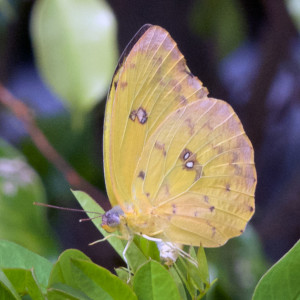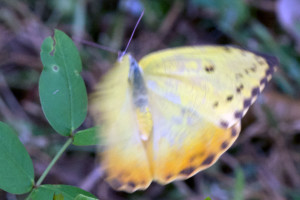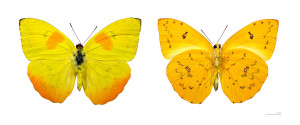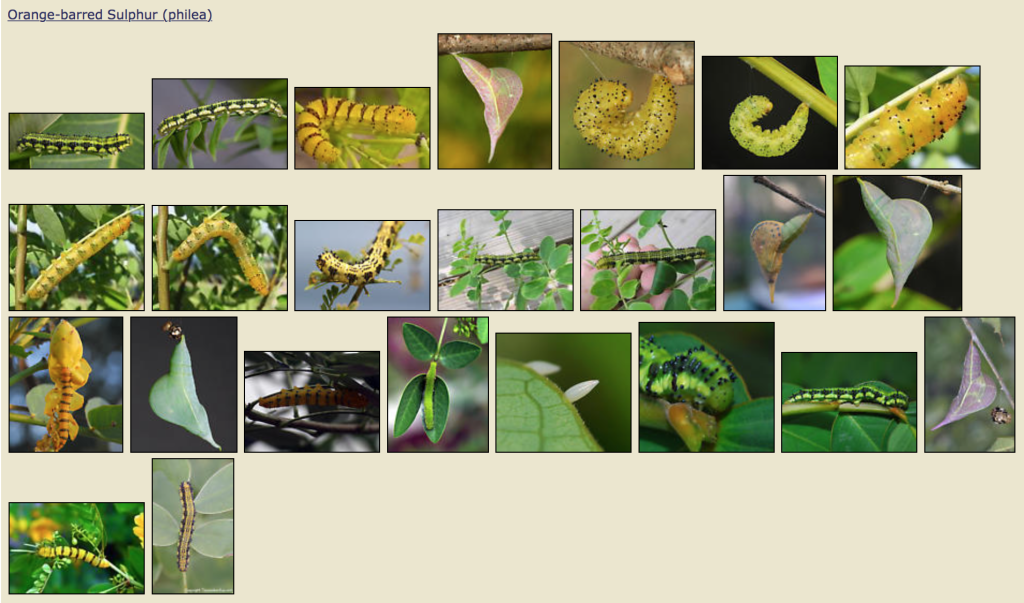I’ve already mentioned how glad I’ve been to have the Bahama Sennas I put in last spring (Senna mexicana var. chapmanii). They’ve attracted my “everyday” sulphur, Cloudless (Phoebis sennae), a nice Sleepy Orange (Eurema nicippe), and now a new butterfly for the yard (one of the only new insects discovered in this windy, windy November), the Orange-barred Sulphur (Phoebis philea):

As soon as I saw it, I knew it was a different butterfly than any of the ones I’d seen before. Its size alone made it stand out; this is Florida’s largest sulphur butterfly, even larger than the appropriately named Giant Orange Sulphur (P. agarithe). The cloudless sulphurs I see every day, while not exactly shrimpy, look small compared to this hulking giant.
The color also made it stand out. The entire underside (that is, what’s visible when it has its wings closed) was “rusty” orange, and the orange was particularly prominent when it was flying. I managed to capture a moderately nonhorrible image of the hindwing orange area, although it’s nothing to write home an entire blog post about:

The orange at the base of the female’s hindwing is not the “bar” referred to in the name, though. The orange-barred part of the name comes from the male, which has a thick orange “bar” on the forewing (In case you didn’t know, in describing an animal, stripes run vertically, while bars run horizontally.):

According to almost all of my books, the orange-barred sulphur colonized Florida from the West Indies in the late 1920s.1 According to Cech and Tudor, it is less migratory than our other sulphurs (Cloudless being the “typical”—or perhaps extreme, rather than typical—migratory sulphur, occurring over a wide range at various times of the year.)
Like most sulphurs, its larval host plant family (what the caterpillars eat) is the sennas in the genus Cassia (as opposed to the sennas in the genus Senna—plants are awesome!).
The caterpillars of the Orange-barred are highly variable green or yellow, but no matter what basal color they have, they have bold markings that make them quite a bit more colorful than the green-with-a-yellow-racing-stripe Cloudless cats:

However, I have yet to find one on my property; all of the candidate caterpillars I’ve found have turned out to be early instar cloudless sulphurs; as they grow, they get greener and greener.
Caterpillars of all the sulphurs appear to prefer to eat the flowers, although the leaves will do when there are no flowers present. (And there are rarely flowers present, since there are so many generations of caterpillars, and they all prefer the blossoms, or if those are absent, the buds.)

ThAnk you for the information. I have taken an interest in those Yellow and orange type Butters.
I have two types of Sennas. The Candlelight and another type I do not know the name but has tiny leaves with yellow flowers(of course). I’ve grown them both from seeds.
This last one after flowering she put these about two inches thin pods that’s sort flat with grooves. Not all seed pods have developed seeds in them. Took me about ten pods to find three viable seeds. Two spoiled and only This one survive. This last one will become like a ten to twelve feet small tree. I’ve seen a few in my neighborhood. Mine is about four feet And so far has given me four generations of different types of catterpiller. Only once there were two different types of caterpillars.
I know that on the Candlelight ants attack the eggs, so I started to cut parts of the branches where there are five to ten eggs on then new growth. Remove all the ants from those branches. Put a number of these branches inside flower bases with water to keep the branches as fresh as possible. Then I put the bases inside a deep aluminum tray with water, make sure any leaves or part of braches are touching walls or outside or ground. The number of eggs becoming caterpillars has increase significantly. I let the caterpillars grow a few days before transferring them back to the Candlelight Senna. I’ve note they transfer well to the Candlelight, but not to my other Senna. Put of five or ten only one stay on this other Senna. The other ones try to walk off. So I catch them and transfer them myself. The Candlelight attract a lot of ants and working on reducing the amount of ants on these bushes. I don’t want to spray poison but I remember that some years ago I had an ant problem in the trunk of my car. I bought a box of Ant Poison Baits Hotel. These ant take the bait back to the brood and poison not only themselve but everyone they feed. Am working on increasing caterpillars’ survival rate on
Too many eggs seem to be eaten by ants. Am trying to research and find out wheather all butterflies eggs are fertile. My unnamed Senna doesn’t seem to attract that many ant. Most the ants I see on the Unnamed Senna are very small and do not seem to molest the eggs. Eggs seem to be larger than these ants themselves.
Any one that can recognize the name of the Senna based on the characteristics I gave appreciate it.
Any one with ideas on controlling ants on the Candlelight Senna will be welcome. Even it they have ideas they haven’t tried themselve but still think the procedure may work.
Thank you.